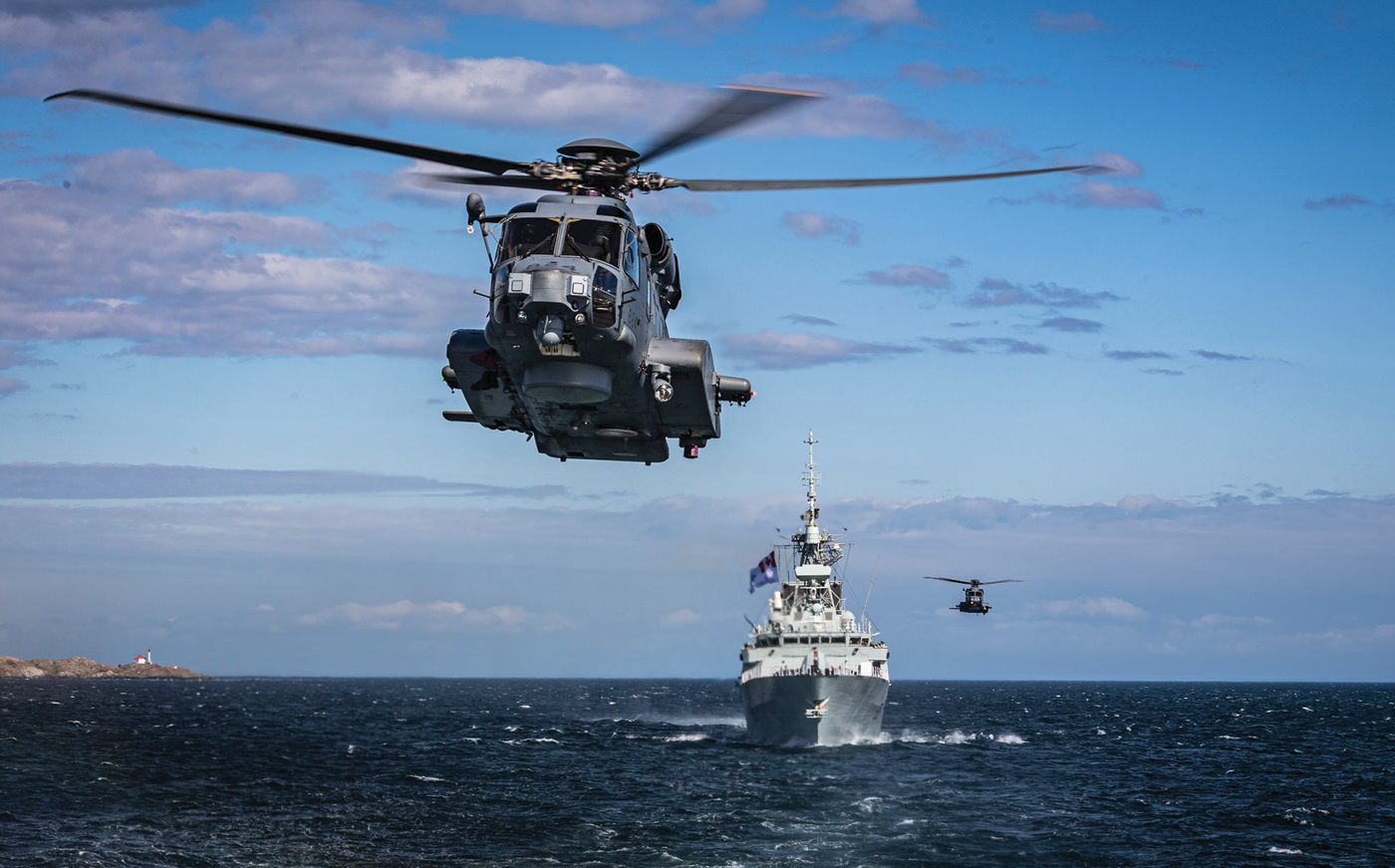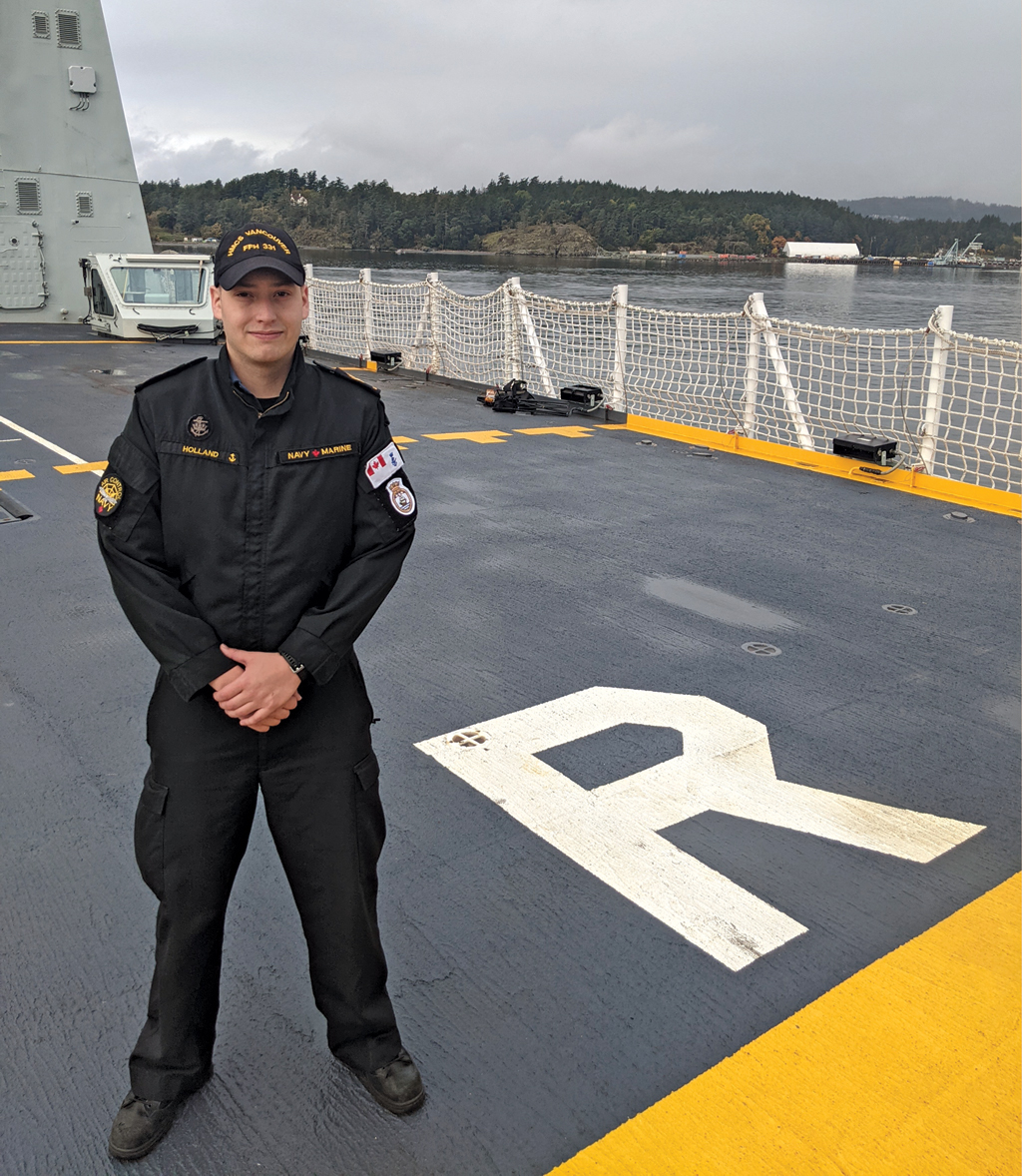Charting a new career flight path in the RCN
By Lookout on Oct 18, 2021 with Comments 0

The CH-148 Cyclone helicopters (seen here accompanying HMCS Winnipeg and HMCS Regina) are the RCNs main ship-borne maritime helicopter. Photo by MS Dan Bard, Canadian Forces Combat Camera
Peter Mallett
Staff Writer
––
He was looking for a bigger challenge on his career path and ended up with a job landing helicopters on the flight decks of RCN ships.
Today Naval Combat Information Operator (NCIOP) MS Nelson Holland says he is fully enjoying his new job as Shipbourne Air Controller (SAC) onboard HMCS Vancouver.
The 26-year-old from Sanford, Manitoba began his service in the RCN seven years ago. Prior to completing his SAC training in May 2021 he was employed as an Air Raid Reporting Operator and Track Supervisor within the NCIOP trade.
“I decided to volunteer for the SAC course because I wanted a greater sense of accomplishment and something that would keep me more engaged in my job and have a tangible impact on operations,” says MS Holland.
“After being approached by other air controllers in the fleet and being given additional insight into the job, I decided it would be a good fit and provide the sense of accomplishment I was looking for.”
Shipbourne Air Controllers are responsible for the tactical air control of helicopters, fixed wing marine aircraft as well as international aircraft excluding fighter jets. Their job and title is a recognized NATO qualification granted to combat operators from naval trades including NCIOP, Naval Electronics Sensor Operator (NESOP) and Sonar Operator. The job itself is similar to an air traffic controller, but SACs also provide tactical or radar control when pilots and their air crews are not capable of detecting threats.
“I quickly discovered that being a SAC puts you into an advisory role to command for everything to do with the employment of air assets,” says MS Holland. “I find myself contributing to many different evolutions involving our shipborne helicopter or other aircraft. The SAC plays an important role in many operations vital to a warships at sea.”
Learning Curve
Fulfilling a role of increased responsibility in day-to-day tactical operations onboard and gaining a sense of accomplishment was exactly what he wanted. However, MS Holland did not achieve this new qualification without overcoming significant challenges. He stresses the 10-week-long SAC course was among the most demanding military training he has encountered.
“The learning curve can be steep at times but with adequate preparation and some studying it is absolutely attainable for anybody motivated to succeed,” he said.
He believes to be a successful SAC you must be adaptable, reliable, proactive and able to function autonomously.
MS Holland credits his success to the mentorship and guidance of senior non-commissioned officers including Vancouver’s Coxswain CPO1 Robert Ferguson, and PO2 Richard Charland of Naval Fleet School Pacific.
That mentorship was never more welcome than the first time MS Holland guided a CH-148 Cyclone to a landing on HMCS Regina. “Too be honest it was a nerve-racking experience to say the least, a bit of an adrenaline rush, followed by great relief,” he said. “With PO2 Charland’s guidance my confidence and competence grew with each successive landing.”
In August 2021, Holland was one of four SACs at the Base promoted to Master Sailor and provided a raise in pay.
Combat Operators can request the course once they attain the S1 rank, and have the recommendation from their Commanding Officer and career manager, says CPO2 Warren Beattie, Chief NCIOP with Sea Training Pacific and acting Fleet SAAC.
Landing a Cyclone
Working in the Operations Room on Vancouver MS Holland has a range of sophisticated electronic equipment at his disposal. A two-way radio and giant computer monitor which displays radar, video output of the flight deck and tactical information for modifying equipment settings are normally his go-to tools for landing helicopters says MS Holland. Also important, is a secondary independent radio which relays weather and ship data that provides the SAC further awareness of what is happening around the ship.
The information relayed to the SAC from a helicopter’s sensors is extensive says MS Holland. It may include positional data and observations on civilian maritime traffic, other military units at sea, data collected from helicopters, sonar or underwater contacts and anomalies or situational information regarding the mission itself.
It all takes place in a fluid environment where the plan might change at a moment’s notice due reasons ranging from a shift in weather to a change in mission to an emergency.
MS Holland has been at his new job for five months and says the learning never ends. That has been especially true lately as he and his shipmates prepare for the upcoming Task Group Exercise (Oct. 12 to 22) off the coast of Vancouver Island.
“There is significant preparation that goes into air controlling and there likely won’t be anybody to tell you what to do every step of the way,” he explains. “Circumstances change and situations arise that must be handled promptly as you are responsible for the safety of a multi-million-dollar asset as well as the lives of the aircrew.”
A spokesperson for Maritime Forces Pacific (MARPAC) said they are hoping to encourage additional interest amongst combat operators towards earning their SAC qualification.
––––
Filed Under: Top Stories
About the Author:






